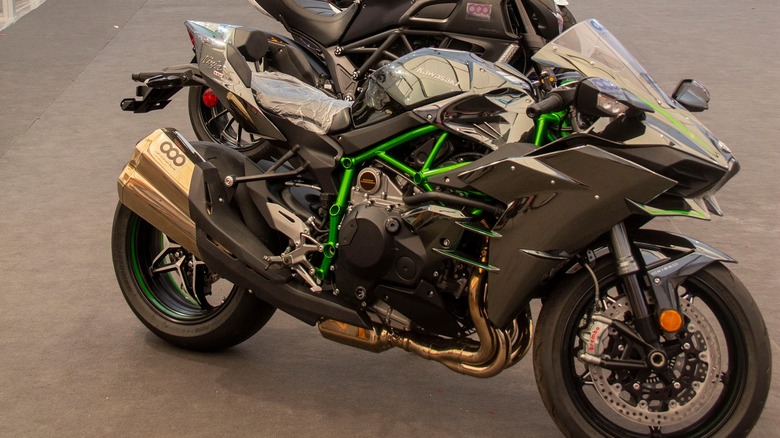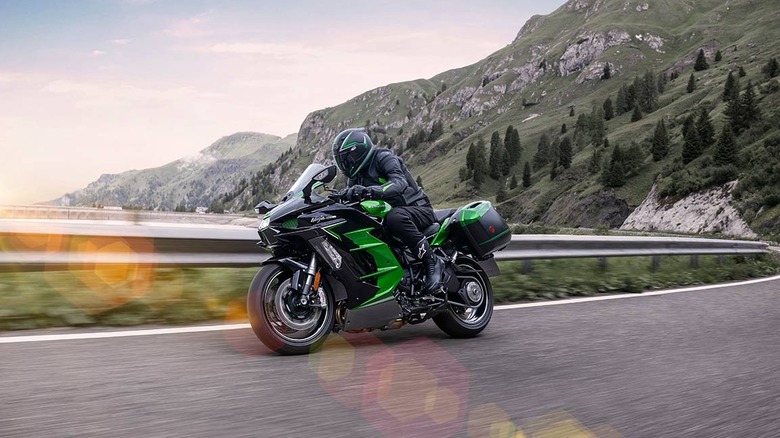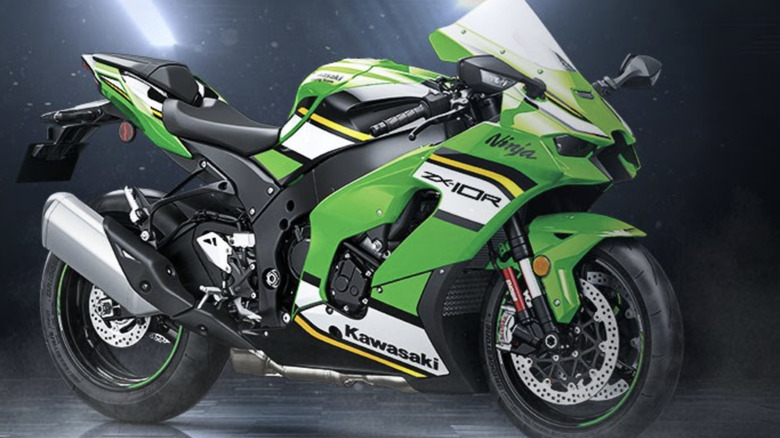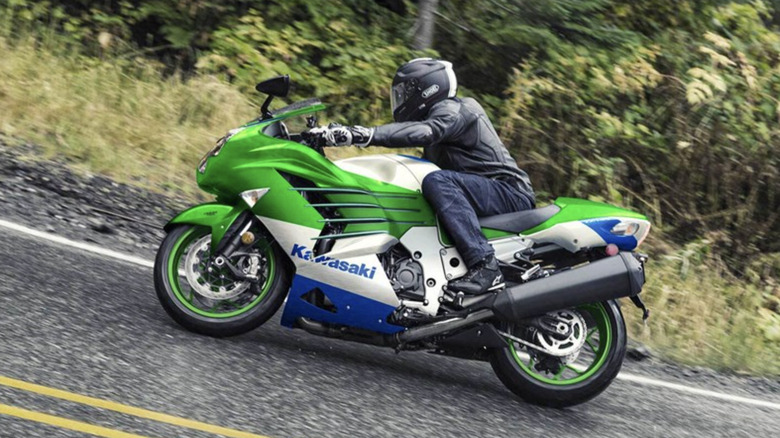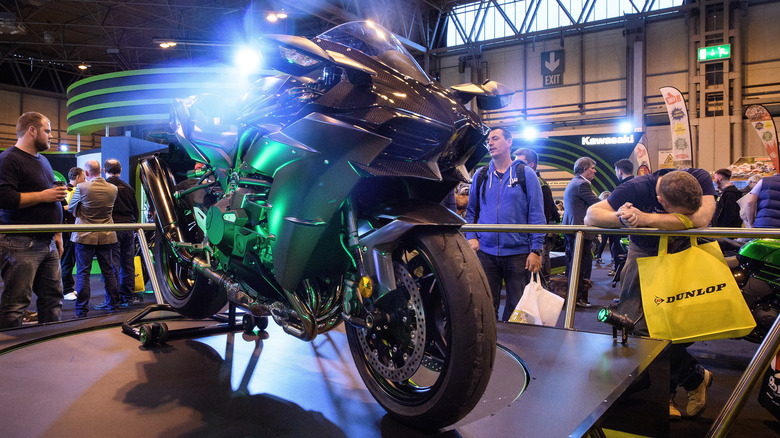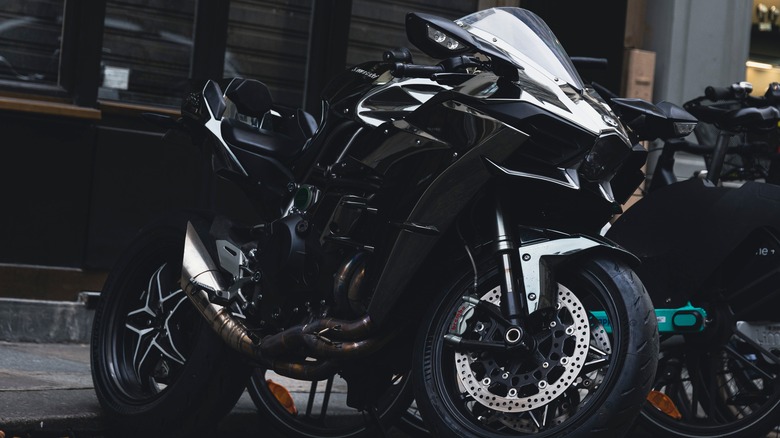Every Kawasaki Model With Over 200HP
Shozo Kawasaki founded the company that bears his name in 1878 as a developer and producer of shipping industry products. Within two decades Kawasaki had expanded to provide parts for automobiles, trains, and airplanes. It was the aircraft division that led Kawasaki into the motorcycle industry by way of a partnership with Meguro Manufacturing. The two companies jointly produced the first Kawasaki-branded bike in the 1960s. That model, the B8, had a 125 cubic centimeter, two-stroke, single-cylinder engine that produced less than eight hp. Kawasaki split from Meguro the next year and got to work on more powerful motorcycles.
The Z1-R was in limited production in the late '70s, and had a 998 cubic centimeter four-cylinder engine that put out 90 hp. It was Kawasaki's response to the Honda CB750 and CR750, and was followed up by the Z1R, which had a 1,015 cubic centimeter powerplant that was capable of 130 hp with the optional turbocharger installed. In the decades since, motorcycle engine technology has evolved to the point where 200 hp doesn't even crack the list of the top five most powerful bikes on the market today. The 200 hp mark still serves as a benchmark for knuckle-whitening performance, though, and Kawasaki has a handful of bikes that meet or exceed that threshold.
The Ninja H2 SX SE puts out an even 200 hp
The Ninja has been at the top of the Kawasaki line in terms of performance since it debuted in the 1980s, and the current Ninja offerings are as impressive as any motorcycles on the market. The Ninja H2 SX SE might have a model name that barely fits on the wings of the fairing, but its supercharged 998 cubic centimer I4 engine cranks out an even 200 hp and is supplemented with advanced electronic rider assist systems to help keep you safe in the pilot's seat. Bosch radar sensors in front and back enable active cruise control, blind spot warning, and forward collision detection systems.
There's an active cornering system that modulates power and braking even under changing conditions, as well as launch and wheelie control to handle aggressive applications of the throttle. The H2 SX SE also has automatic high-beam detection and vehicle hold assist systems, all of which contribute to the $28,000 base price.
The Ninja ZX-10R is Kawasaki's next step up in performance
The Ninja ZX-10R is a supersport bike inspired by Kawasaki's WorldSBK models, and its engine is tuned to produce 203 hp. The ZX-10R is available with electronic traction, launch, and engine brake control, as well as active cornering management, which Kawasaki brands as KCMF (Kawasaki Cornering Management Function). The ZX-10R is available in several variants, including KRT (Kawasaki Racing Team) and 40th Anniversary editions, which come with special graphics packages. The ZX-10RR is made for the racetrack and has a variable air intake system, lightweight engine internals, Marchesini forged wheels, and Pirelli Diablo Supercorsa tires.
The ZX-10R and its variants were updated for 2021, and introduced smartphone integration to the Kawasaki superbike lineup. The fairing was updated with winglets to provide 17% more downforce on the front end, and the swingarm and suspension got tweaks as well. The first three gears were shortened to boost acceleration, and Chris Northover of Cycle World called the cumulative effect of the updates "confidence-inspiring all around."
The Ninja ZX-14R has a 1,441-cc engine
For riders that want something a little beefier, the Ninja ZX-14R has a 1,441 cubic centimeter inline four that puts out as much as 208 hp. It also has features similar to the ZX0-R's that are aimed at making your ride more safer and more comfortable. The ABS version comes with traction control, anti-lock Brembo brakes, and adjustable foot pegs and handlebars. The larger engine is a bit thirsty, gulping fuel at the rate of about 34 miles per gallon, but the 5.8-gallon tank still gives you a cruising range of almost 200 miles.
The fully adjustable 43 millimeter inverted front forks offer 4.6 inches of travel, and the Uni-Trak monoshock in back extends as much as 4.9 inches and provides a ride height adjustment. The ABS model starts at $16,599, and the 40th Anniversary edition will cost you an additional $650. Cycle World's Nick Ienatch summed up the results of their long-term test by noting that "it was the 14R's livable ergonomics, calming stability, and impressive chassis that made our 10,000 miles flash by."
Two Ninja H2 models produce 228 hp
The top-of-the-line streetable Ninja in terms of performance is the H2, which comes in ABS and Carbon variants. Both are powered by a supercharged 998 cubic centimeter inline four-cylinder engine that puts 228 hp to the rear wheel. As the name implies, the Carbon version has a carbon-fiber front fairing. The H2 was introduced in 2015 and updated in 2017 and 2019, and is now outfitted with Bridgestone RS11 tires, which are equally suited to the road and racetrack.
Kawasaki's Rideology app links your smartphone to the Thin-Film Transistor (TFT) display, which also displays telemetry data from the Bosch Inertial Measurement Unit (IMU). The latest update to the H2 includes "self-healing" paint, which can reseal small scratches without the need for a touch-up tube.
Michael Neeves of Motorcycle News had high praise for the H2's refined beastliness, writing that "its supercharged power delivery is still deliciously smooth and thanks to its excellent electronics, accessible, too."
The Ninja H2R isn't street-legal
While those bikes certainly offer impressive performance that's more than enough for most riders, Kawasaki doesn't come close to stopping there. The racetrack-only Ninja H2R has a 326 hp inline four engine capable of a three-second zero to 60 sprint and an eye-watering, bug-slaughtering top speed of 248 miles per hour. This is quite a bit faster than the street-legal ZX line of Ninjas, which are electronically limited to a maximum of 186 mph. The H2R will set you back a whopping $58,100, which is a hefty price to pay for a bike that you can only use in competition.
Of course, the H2R is outfitted with the same advanced electronic ride management systems as its less powerful brothers, including KCMF, traction control, and launch control. But even if you can afford one, you might have a hard time finding a place to ride your H2R. Adam Child of Motorcycle News noted that "the exhaust is so noisy that very few circuits will allow its type on trackdays," and pointed out that you might need access to an airport runway or private road to put it through its paces.
